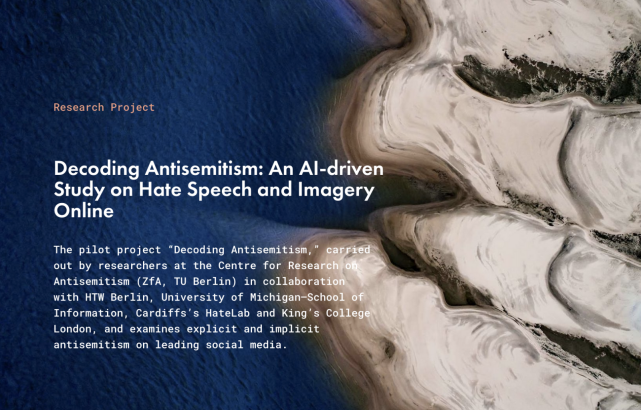Matthias J. Becker leads the innovative research project Decoding Antisemitism and has for many years been advocating for a new approach to social media studies in the fight against hate speech and societal radicalisation. In this article he presents some results of deeply worrying primary research into online reactions in Europe to the events of 7 October. ‘The massive antisemitic violence of 7 October was frequently met with direct affirmation, justification, relativisation, or even denial in online comments,’ he writes, while ‘in response to Israel’s subsequent military actions, classic or updated stereotypes and demonising analogies were added’.
Antisemitism is a hate ideology that has adapted to political, cultural, and societal contexts throughout its over two-thousand-year history. With the establishment of the State of Israel in 1948, a new focal point emerged for antisemitic agitation. Alongside the mere existence of the Jewish state, it is the escalation phases in the Middle East conflict that have consistently triggered global waves of antisemitism. Every confrontation, every act of terrorism, every reaction from the Israeli military has led to an increase in the reproduction of stereotypes and other forms of antisemitic communication, both offline and online. The correlation between such events and the rise in antisemitic discourses has shown continuity. Even the terrorist attack by Hamas on Israel on 7 October 2023, did not change this—however, this event was a turning point.
Looking at the media portrayal of the atrocities on 7 October, this correlation seems to have finally arrived in the age of the interactive web. What previously triggered a concentration of antisemitic expressions, forms of relativisation, or even denial of committed crimes, now led to open hatred or the glorification of the massive violence committed against Israeli civilians on that day. Hence, it wasn’t fantasies about Jews that shaped the discourse, but forms of so-called self-positioning often characterised by schadenfreude towards the Jewish victims. At least in the context of web-related antisemitism studies and mainstream discourse, this is a clear novelty.
In the following, I will present some results of the research project ‘Decoding Antisemitism,’ which examines, among other things, how reactions to the events of 7 October were expressed on different platforms in various languages. How was the response on social media when users were confronted with the news from southern Israel? And what does that tell us about the relationship between antisemitism and conspiracy thinking as well as about their tabooisation within the focused language communities?
METHODOLOGICAL APPROACH AND RESULTS
The Decoding Antisemitism project[i] employs a corpus linguistics-oriented approach. This involves forming datasets based on specific criteria such as text type, platform specificity, discourse event, or measurement period, followed by the examination of communication patterns within these corpora. The case studies discussed in this article, focusing on 7 October, are derived from data collected from two platforms: YouTube and Facebook. The project primarily concentrates on the profiles of mainstream media outlets in Germany, France, and the United Kingdom, with consideration given to other European countries for contrast.
Given that antisemitism in politically moderate circles often manifests in coded ways, the primary method of analysing online data is qualitative content analysis.[ii] Conventional quantitative methods may not fully capture the complexity and diversity of interpersonal communication, especially concerning tabooed hate ideologies, where discourse participants typically reject being labelled as ‘antisemitic.’ This leads to ‘creative’ communication patterns and implicit hate speech, where antisemitic attitudes are conveyed through wordplay, allusions, metaphors, irony, or rhetorical questions.[iii] Given the diversity and complexity of these patterns, comprehensive recognition of antisemitism in such environments can only be achieved through context-sensitive analyses. Clarifying relevant questions allows conclusions to be drawn about which stereotypes have gained some societal acceptance.[iv]
Our research reveals a significant increase in antisemitic comments compared to other instances of violence in the Middle East on 7 October.[v] The majority of these comments consist of approval, glorification, and justification of Hamas terrorist attacks. The frequency and directness of these comments vary based on the platform, language of the users, and the specific topics discussed. It’s notable that the number of comments endorsing the atrocities of the attacks rises significantly when the reports concern attacks on Israelis or Jews compared to general reports about the current phase of the conflict.
Following the aforementioned self-positioning, the most prevalent antisemitic concepts in these comments include denial of Israel’s right to exist, unilateral blame on Israel, demonisation of Israel as a terrorist state, conspiracy theories, and perceptions of Israel as an embodiment of absolute evil. Consistent with previous studies conducted by the project, this analysis identifies a variety of antisemitic concepts and communicative strategies. The results underscore the multifaceted nature of antisemitism, presenting a complex mosaic that cannot be fully addressed all at once. Therefore, this discussion focuses on highlighting the most prominent trends.
YOUTUBE PROFILES OF BRITISH MEDIA
The YouTube corpus of British media is the largest dataset in our study, with 4000 comments.[vi] Typically, we observed antisemitism in 15 to 25 per cent of social media comments on reports about the Arab-Israeli conflict in the British context. With the current escalation, this proportion increased dramatically in YouTube comments—sometimes reaching 30 to 40 per cent or, as in the case of a thread from ‘Independent,’ nearly 55 per cent. This thread notably refers to a video detailing the massacre in Kibbutz Kfar Aza. The high density of antisemitic comments under clips about Hamas crimes and thus the discrepancy between media perspective and overt antisemitism was a surprising finding, as we initially assumed solidarity or at least restraint from commenters.
Affirmation of antisemitic violence occurs both directly, with statements like ‘Long overdue,’ ‘The Palestinians are finally fighting back,’ ‘Good job Palestine,’ and ‘So happy to see justice finally.’ Other statements, which in different situations are not laden with antisemitic meaning, include ‘Allahu Akbar,’ ‘Long live Palestine,’ or ‘Resistance is yours.’ In the context of the media presentation of the terrorist attacks, such comments equate to affirmation and can be read as implicitly wishing death upon Jews. The fact that the communicated attitudes target not only Israelis but also Jews in general is demonstrated by wordplay and allusions such as ‘JURN THE BEWS’ and ‘The Palestinians will complete the job that the Austrian painter started.’
Schadenfreude is particularly common in comments about the massacre at the Supernova music festival: ‘Peaceful community must treat like this everywhere,’ ‘Hahahah why r u runnin???,’ ‘This is better than Hollywood!’ Two clips shared by ‘Independent’ about the abduction of female civilians elicited strong approval of sexual violence: ‘They had a good time with her it seems like,’ ‘That’s the price paid for being cute.’ In this context, justifications for sexual violence also arise: ‘This woman was in the Israeli army so she should be treated like this.’
In addition to affirming violence, many comments express antisemitic attitudes towards Israel. In 9 to 22 per cent of antisemitic comments, Israel’s right to exist is denied, as seen in statements like ‘Only the Palestinians exercise their ‘right of return’ to their ancestral land’ and ‘Third Intifada! Full independence this time!’ A nearly equal proportion places sole blame on Israel in the conflict, as in ‘Feel the pain of how Israeli massacred Palestinian kids for 70 years’ or ‘Tell that to the Palestinian women and children who have had to endure this for 75 years. Revenge is good. They deserve it.’ This perpetuates the classic stereotype of Jewish guilt for the hatred directed towards Jews throughout history.
This form of unilateral blame can also be indirect—through phrases like ‘Karma!!!! The irony is killing me,’ ‘What goes around comes around,’ ‘It’s Hostages taking Hostages, let’s get it right!’ and ‘sow the wind reap the storm.’ The alignment of such conceptualisations with ancient stereotypes is evident in statements like ‘We wouldn’t have had this war in the first place if the religion about the whole land has been ‘promised by god for ‘the god’s chosen’ never existed’ or ‘end of isreal rise of humanity.’
Other antisemitic patterns on British media YouTube profiles include conspiracy myths and denial of crimes: ‘fake news,’ ‘I agree seems staged.’ Beneath an interview, comments include ‘random soldier, fluent English,’ ‘cui bono? Who benefits … ?’ and ‘The ‘hasbara‘ is fantastic; tentacles far and wide.’ Additionally, a connection to September 11, 2001, is made: ‘The irony that it was dancing, Israelis gunned down today and on 9/11 it was the ‘dancing Israelis who knew about the World Trade Center’ and ‘documented the incident for Israel’ instead of alerting America and stopping September 11th.’ In terms of denial strategies, users frequently cast doubt on the antisemitic motivation of the perpetrators: ‘Hamas chose Saturday because they knew that the Israelis were not working so as to avoid civilian casualties. How honorable you are. May God help the Palestinians against the Israeli terrorists’ and ‘brother, they literally took an Israeli mother to safety with her child, the only beating they are doing is to the soldiers.’
In addition to glorifying and justifying terrorism, there is a focus on specific antisemitic concepts, which, while not reaching the high frequency of the aforementioned self-positioning, still influence online discourse. Denial of Israel’s right to exist, allegations of sole blame, and claims of a Zionist-Jewish conspiracy have served as pillars of Israel-related antisemitism in other discourse events as well.
GERMAN MEDIA YOUTUBE PROFILES
The proportion of antisemitic comments in the 2000-comment German YouTube corpus varies widely, up to 25 per cent. Interestingly, all six threads with percentages over 20 per cent focus on Hamas’ atrocities.[vii]
Similar to British media profiles, antisemitic comments on German YouTube profiles also feature affirmation of violence, terror, and murder. In the 20 examined threads, statements glorifying violence make up over 41 per cent of antisemitic comments. Users repeat the calls of Hamas terrorists such as ‘Allahu Akbar,’ make vague demands like ‘Freedom for Palestine,’ or ask, ‘Can you blame the Palestinians?’ Early on, paraglider emojis are used to celebrate Hamas terror. Clearer approval can be found in statements like ‘Maşallah SubhanAllah keep it up guys,’ ‘Clean performance,’ ‘We can be proud!’ or ‘Hamasssssss will win!’ Some users use emoticons to spread racist stereotypes about Jews and ‘infidels’ in general, expressing indirect threats against the entire West mentioned in the context of the thread.
The affirmation of violence and terror is combined in almost every fourth comment with the assertion that Israel bears sole responsibility for the conflict. Phrases like ‘Who sows the wind will reap the whirlwind!’ or ‘That’s what comes from such things’ indicate the belief that Israel cultivated Palestinian terror itself. This is not always about Israel’s dealings with Gaza but about its existence itself. In addition to assigning blame, conspiracy myths are widespread, with over 12 per cent: ‘How can such a well-connected intelligence service like the Mossad miss such a huge enemy operation? That smells like a false flag …’; ‘This was allowed to escalate the situation.’ Even on clips showing emotional interviews with the parents of Israeli hostages, users respond with little empathy and accuse them of staging attacks for specific purposes: ‘[The father] is an actor’ and ‘Out of sheer sadness open up a new settlement area and block food transports. That helps morale a bit.’
The arsenal of antisemitic communication, however, is more diversified. We see various forms of relativisation and denial of the antisemitic nature of the terrorist attacks, along with insinuations that Israel has a ‘blank check’ and instrumentalises antisemitism. Numerous comments also contain comparisons to the Nazi regime, surpassed only by affirming references to the Nazi era. Users also interpret the escalation in the Middle East against the backdrop of the war in Ukraine and resort to openly antisemitic jokes regarding potential Israeli refugees: ‘Where do you want to take in the Jews when gas is so expensive in Germany now?’
It is noticeable that there are numerous similarities between British and German YouTube channels. However, a significant difference lies in the lower frequency of antisemitism on the German side. Unlike the patterns in the British dataset, it’s also notable that conspiracy myths appear more frequently on German channels than questioning Israel’s right to exist. This could be related to the fact that the indirect demand for the annihilation of the Jewish state too closely activates the idea of mass murder and thus is not compatible with the image of acceptable ‘critique.’ Various case studies in recent years have shown that readers of British media express antisemitic ideas much more directly and aggressively than users in German-speaking contexts, although the presence of antisemitic expressions in any country largely depends on the trigger of the discourse.[viii]
FACEBOOK PROFILES IN THE UK, FRANCE, AND GERMANY
Looking at Facebook profiles of British, French, and German media, we see that on 7 October and the following days, affirmation of violence, often combined with Schadenfreude, was prevalent there as well. In France, such comments make up 53 per cent of antisemitic comments. The figures for British and German Facebook profiles, at 33 and 19 per cent respectively, are slightly lower than on YouTube during the same period. Remarkably, in the German corpus, affirmation of terror is surpassed by the notion of Israeli sole guilt.
Similar to the YouTube case study, violence affirmation on British Facebook profiles is followed by the idea of Israeli sole guilt, the notion that Israel is a terrorist, apartheid, or even Nazi state, and often, denial of Israel’s right to exist.
On French profiles, similar patterns are visible. However, these are complemented by various religious justifications for violence, such as ‘Eye for an eye, tooth for a tooth; it’s the law of retaliation, and it is prescribed in the 3 religions of the book’ [‘Oeil pour oeil, dent pour dent; c’est la loi du talion, et elle est prescrite dans les 3 religions du livre’]. Nazi comparisons are also part of the discourse, with Hamas, for example, being compared to the Resistance. And finally, there’s the assertion of Jewish instrumentalisation of 7 October for pecuniary purposes.
In the German discourse, with its focus on the question of guilt, concepts of Israel as a supposed terrorist or Nazi state or generally as a world evil take a central place in online debates. At the same time, events in the Middle East in the Facebook comment sections, as well as on YouTube, are a central trigger for criticism of German foreign and migration policy, as well as a significant increase in anti-Muslim racist expressions.
Overall, it can be observed that amidst the numerous antisemitic comments on the Facebook profiles of various media houses, there are fewer neutral reactions than usual. It seems that recent events have further narrowed the space for grey areas even in seemingly politically moderate milieus, polarising the debate and radicalising discourse on both sides.
CONTRAST WITH OTHER COUNTRIES
The analysis of six additional country-specific case studies on the initial reactions to 7 October shows how adept antisemitism is at adapting to national contexts, maintaining its high degree of attractiveness even when confronted with massive violence, using its broad arsenal of stereotypes and other concepts.[ix]
Our Italian corpus shows the lowest frequency of antisemitic reactions, just below 10 per cent, compared to other language communities, but the underlying concepts are identical. Antisemitic comments tend to either blame Israel solely or celebrate Hamas attacks. A significant number of comments justify Hamas attacks by demonising Israel, either through comparisons with a terrorist state or through Nazi analogies. In many cases, Israel’s right to exist is also denied.
In the Spanish Facebook dataset, 17 per cent of the analysed comments were classified as antisemitic. Many comments welcome Hamas terror and justify it as a legitimate response to previous Israeli actions and thus as self-defence. Many comments show simplistic dichotomous notions of oppressors versus oppressed. As in the Italian corpus, depictions of Israel as a terrorist state (the most common antisemitic concept) or even a Nazi state are used to deny Israel’s right to exist.
In the comment sections of Polish news portals, the proportion of antisemitic remarks averages over 17 per cent, reaching 38 per cent under a post about the Supernova festival. Unlike most other language communities, the most common themes are not glorifications of violence and terror but rather conspiracy myths accusing Israel of being behind Hamas attacks, along with portrayals of Israel as evil and immoral, coupled with notions of a terrorist and Nazi state. Despite many attempts to dismiss antisemitism as a problem of the past or of other nations, threads increasingly reveal deeply ingrained perceptions of Jews as privileged and Holocaust exploiters.
In the Slovak dataset, celebrations of Hamas actions in antisemitic communication account for ‘only’ just under 15 per cent. Forms of demonisation of Israel and an alleged taboo against criticising Israeli politics play a larger role. Occasionally, Israel’s Gaza offensive is decontextualised by being compared to the Russian invasion of Ukraine. There is also an equation of the situation in Gaza with the suffering of Jews during the Holocaust, accompanied by attacks on Israel’s right to exist and depictions of Israel as a foreign or destructive actor in the region. Finally, there are, albeit with lower frequency, comments suggesting a secret conspiracy behind Hamas terror, accusing Israel of benefiting from it.
In the Romanian dataset, 18 per cent of all comments were classified as antisemitic. Unlike in other European contexts, Israel-related concepts are less present, while classic antisemitic motives and slurs dominate, pointing to the perception of Israel as a ‘collective Jew.’ Furthermore, the threads show a variety of antisemitic conspiracy myths, ranging from global dominance to references to the Khazars.[x]
In Morocco, due in part to the central importance of the Palestinian cause, there is a comprehensive problem with antisemitism, as evidenced in the corresponding corpus. About 31 per cent of the analysed comments are antisemitic, often through affirmation and celebration of Hamas terror. Forms of dehumanisation of the victims and denial of Israel’s right to self-determination are widespread, while conspiracy myths or Nazi analogies are hardly observed. In contrast to the Romanian corpus, some users use ‘Zionist’ instead of ‘Jew,’ but eventually always return to reproducing antisemitic motifs.
In a contrasting comparison, it appears that the dominance of the affirmation of Hamas terror is more of a phenomenon in Western contexts (Spain, Great Britain, France), and Morocco, while in the direction of Central and Eastern Europe, other antisemitic concepts have shaped the immediate reactions to 7 October. Especially the threads of Eastern European contexts show that conspiracy myths, as well as classic notions of power and instrumentalisation, still play a significant role—which is also evident in the mixing of terms such as ‘Israelis’, ‘Zionists’, and ‘Jews’.
OUTLOOK
Our ongoing analyses show that in the three focused countries—Great Britain, France, and Germany—the concentration of certain manifestations of antisemitism, which were dominant in the days following 7 October, has now decreased. Now, the affirmation or even glorification of violence and terror has diminished – at least in mainstream milieus online. Instead, Israel is characterised in many comments as a global evil, terrorist, Nazi, or colonial state, and is accused of influence and disinformation. In this sense, a return to the old patterns of Israel-related antisemitism can be observed, without the motives that were predominant immediately after 7 October having completely disappeared.
This highlights how adaptable the ideology of antisemitism is. The massive antisemitic violence of 7 October was frequently met with direct affirmation, justification, relativisation, or even denial in online comments. In response to Israel’s subsequent military actions, classic or updated stereotypes and demonising analogies were added. Thus, the extent to which the events in the Middle East are linked to the situation in one’s own country depends on the position of antisemitism in the different language communities.
Given the sheer volume of online content, the insights presented are nevertheless only spotlights. In the Decoding Antisemitism project, we will continue to investigate anti-Jewish sentiment on social media, as not only does the communication space, language, and communication itself continue to evolve, but so does the hateful ideology of antisemitism. How antisemitism mutates, how the corresponding discourse responds to antisemitic incidents, and how specific narratives about Jewish people are continued and rewritten will remain important questions in the future—especially for political, legal, and above all, educational counter-strategies.
[i] https://decoding-antisemitism.eu.
[ii] Philipp Mayring, Qualitative Content Analysis: Theoretical Background and Procedures, 2014, https://link.springer.com/chapter/10.1007/978-94-017-9181-6_13.
[iii] Jörg Meibauer (ed.), Hassrede and Hate Speech, Gießen 2013; Matthias J. Becker/Hagen Troschke, ‘Decoding Implicit Hate Speech: The Example of Antisemitism’, in: Christian Strippel et al. (eds.), Challenges and Perspectives of Hate Speech Analysis: An Interdisciplinary Anthology, Berlin 2023, 335–352, https://www.ssoar.info/ssoar/handle/document/86423.
See also our comprehensive open-access Lexicon comprising 40 chapters, set to be published in the coming weeks: Matthias J. Becker et al., Decoding Antisemitism: A Guide to Identifying Antisemitism Online, London forthcoming,https://link.springer.com/book/9783031492372.
[iv] The used categorisation system is based on the IHRA (International Holocaust Remembrance Alliance) working definition of antisemitism, which has been further developed for fine analyses within a comprehensive operationalisation framework, https://holocaustremembrance.com/resources/working-definition-antisemitism.
[v] Already by the end of October 2023, the Decoding Antisemitism team published a preliminary study based on over 11,000 YouTube and Facebook comments from 7 October onwards. These comments were directly related to reports from politically moderate news sites. See Matthias J. Becker et al., Celebrating Terror: Antisemitism Online After the Hamas Attacks on Israel: Preliminary Results, Berlin 2023, https://decoding-antisemitism.eu/publications/celebrating-terror-antisemitism-online-after-the-hamas-attacks-on-israel.
[vi] Each, 1100 comments come from the YouTube profiles of ‘The Guardian’ and BBC News, 1000 comments from the profile of ‘The Independent,’ and 800 from the profile of ‘The Times.’
[vii] The corpus consists of 1000 user comments from ‘Bild,’ 300 from ‘Der Spiegel,’ 200 each from ZDF, Arte, and EuroNews, and 100 from WDR. Many German media outlets, such as ‘Die Zeit,’ have disabled the comment function regarding the Middle East conflict.
[viii] Matthias J. Becker, Decoding Antisemitism in European Online Discourses, in: Manuela Consonni/Martina L. Weisz (eds.), Analysis of Current Trends in Antisemitism, Berlin forthcoming.
[ix] For this section, see Matthias J. Becker et al., Decoding Antisemitism: An AI-Driven Study on Hate Speech and Imagery Online, Discourse Report 6, Berlin 2024, https://decoding-antisemitism.eu/publications/sixth-discourse-report.
[x] See American Jewish Committee, Translate Hate Glossary: Khazars, www.ajc.org/translatehate/Khazars.



































